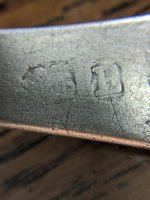Iron Buzz
Bronze Member
- Oct 12, 2016
- 1,749
- 2,380
- 🏆 Honorable Mentions:
- 1
- Detector(s) used
- XP Deus, Minelab Equinox 800
- Primary Interest:
- Metal Detecting
Found in a Civil War era home (1850 Large Cent and 1864 IH came from there, owner died in 1890)
Wondering if anyone recognizes the maker's mark.

A couple of other pics showing what appears to be some sort of monogram on the front of the handle:


Also curious about the metal. It was badly bent. I annealed it, assuming it was silver, and that worked pretty well, but the heat turned the surface a weird pinkish gray and the flame coming off of it when I was heating it was either nickel green or copper blue-green. Is that typical of sterling? (the discoloring polished off easily)
Wondering if anyone recognizes the maker's mark.

A couple of other pics showing what appears to be some sort of monogram on the front of the handle:


Also curious about the metal. It was badly bent. I annealed it, assuming it was silver, and that worked pretty well, but the heat turned the surface a weird pinkish gray and the flame coming off of it when I was heating it was either nickel green or copper blue-green. Is that typical of sterling? (the discoloring polished off easily)

























